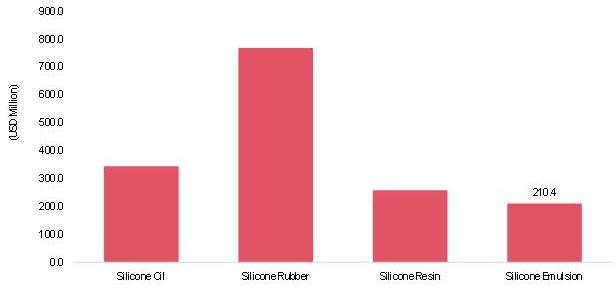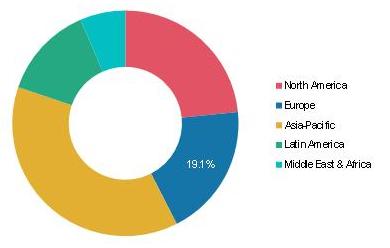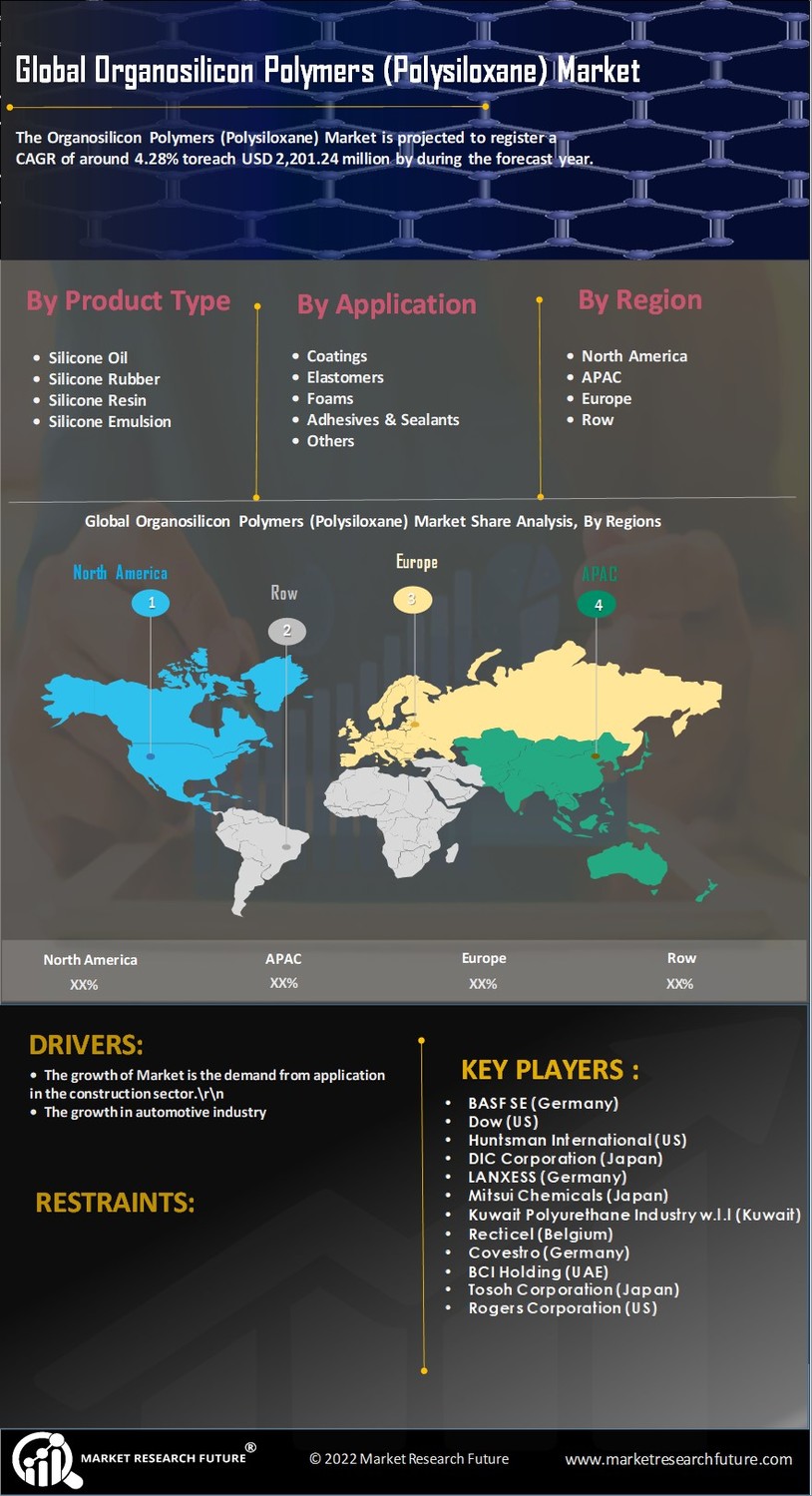Organosilicon Polymers (Polysiloxane) Market OverviewThe Organosilicon Polymers (Polysiloxane) Market is projected to register a CAGR of around 4.28% toreach USD 2,201.24 million by the end of 2028.
Organosilicon polymers composites are organometallic compounds that contain the carbon-silicon bond. Generally, the organosilicon compounds are likeordinary organic compounds and display similar characteristics: flammable, colorless, stable to air, and hydrophobic. For instance, silicone is a polymeric organosilicon compound thatis thermally stable and chemically inert.The polysiloxanepolymer compound has more than one organic group connected with a silicon atom which helps to offer better thermal oxidation stability, electrical properties, and weather resistance.
The prominent factor favoring the growth of Theorganosilicon Polymers (Polysiloxane) Market is the demand from application in the construction sector and from the growing automotive industry,which is opting for cleaner and greener material sources owing to the stringent regulations on emission, especially from the US, EU countries, China, India, and other Southeast Asian countries. They are also used extensively in the application of coatings for protective and industrial purposes. These compounds are also extensively used as fire retardants in various materials.
Silicone compounds are extensively used in the automotive industry. The need for greener and eco-friendly materials in the automotive and transportation sector is expected to create major traction for the market demand. The regulations towards eco-friendly materials and awareness of environmental pollution areexpected to gain major traction for the Organosilicon Polymers (Polysiloxane) Market in the coming years.Additionally, the production and sales increase of passenger cars,especially of thesmall passenger cars such as subcompacts, microcars, and superminis, are significantly highand account for over 33% of total vehicles soldin 2019. According to the Center for Automotive Research, the demand is expected to reach over 32 million vehicles by the end of 2021.
Additionally, some of the recent studies show that synthetic organosilicon polymers can be modified with the help of organic fillers, which are obtained from the waste of plants. These types of organosilicon polymersare generally used in the electronics and semiconductor industries. The application field of silicone compounds includes the thermalprotection systems in which silicone rubber composites are used,which helps to increase theflame retardancy of the electrical cables. It also helps with the production of white light by colorimetric and photometric conversions in light-emitting diode (LED) packages coupled with various applications in marine antifouling surfaces. Siliconecomposites provide elastic technical materials using the correct fillers, and these composites can be used to produce materials with high-performance properties.
However, thetensile strength, hardness, and tear strength properties are very poor in silicone rubber, making them less reliable to produce high-quality products. Contrarily, factors such as technology development, product innovation, and the expansion of the automotive and construction industry in emerging economic regions such as the Middle East and Africa, and Latin America are estimated to create new demands and growth opportunities for the manufacturers in the Organosilicon Polymers (Polysiloxane) Market.
COVID-19 Impact Analysis
The pandemic COVID-19 has impacted demand, supply, inventory, and logistics, among other aspects of businesses across the world.The global covid–19 pandemic has issued a tight supply of the products majorly owing to the reduction in operating capacities in the manufacturing facilities across Asia-Pacific, Europe, and the Americas. The governments and businesses have faced an unprecedented crisis in 2020 as well in early 2021 as they attempt toalleviate the consequences which are caused by the novel coronavirus pandemic.
The indefinite halt of world travel has radically changed the market demand and disrupted the global supply chains. The pandemic has affected and continues to impact the various industry verticals; whilefood and medicine-related industrial sectors continue to gain high demand and priority, other verticals such as transportation, construction, electronics, automotive, oil & gas have suffered from low sales and demand. Some countries, however, have opened their borders, the market demand is still less than the pre-pandemic levels. As the global economy starts to recover, companies have started with continuous R&D and are making impacts studies on their supply chains –from their sourcing and workforce to its supply chain suppleness.
The chemical industry helps to produce over 96% of manufactured goods globally each year. This industry is responsible for manufacturing over 70,000 diverse products out of its raw materials, which have their application in the agriculture, food, healthcare, transportation, consumer goods, and building & construction sectors. The demand for chemicals isa direct function of the demand created by the customers. Although the chemical industry has been affected negatively in some sectors such as automotive and construction, it has benefitted in other sectors such as medical equipment and packaged food. Moreover, the companies are working aggressively toward safeguarding the health and wellbeing of their employees while also supporting government goals of maintaining critical business activities in power generation, food production, and healthcare.
There are numerous fiscal and monetary policies that governments across the globe implicate to mitigate the impact of COVID-19 on the industrial sector whileproviding some relief to itsconsumers. According to the United Nations, the global economy is expected to decline by about 3% or more instead of recording a 2.5% growth which is projected by the World Economic Situation and Prospects report 2020.
Supply Chain Analysis
The supply chain analysis is the process of evaluating every stage and step taken by stakeholders involved throughout the production and distribution of organosilicon polymers (polysiloxane). The supply chain includes raw materials and suppliers, Organosilicon Polymers (Polysiloxane) producers, distribution channels, and endusers.
The key raw materials used in the production of organosilicon polymers (polysiloxane) include carbon and silicone. Some of the key suppliers are Dow, Wacker Chemie AG, Shin-Etsu Chemical Co. Ltd., Elkem ASA, and KCC Corporation,among many others.
The distribution channel in this market comprises distributors, wholesalers, and e-commerce merchants.
Segmentation
The Organosilicon Polymers (Polysiloxane) Market has been segmented on the basis of Product Type, Application, and Region.
By Product Type, the Organosilicon Polymers (Polysiloxane) Market has been segmented into silicone oil, silicone rubber, silicone resin, and silicone emulsion. The silicone rubber segment accounted for the largest market share in 2020 due to its wide use in the automotive sector. It is aimed to reducethe carbon footprint from various parts.
Based on the Application, the Organosilicon Polymers (Polysiloxane) Market has been categorized into coatings, elastomers, foams, adhesives & sealants, and others.Among these, the coatings segment emerged as the fastest-growing segment during the review period.
Global Organosilicon Polymers (Polysiloxane) Market Revenue, by Product Type, 2020 (USD Million) Sources: MRFR Analysis
Sources: MRFR Analysis
According to the product type segment, the market is expected to gain major traction from the silicone rubber segment. However, the silicone oil segment is expected to be the fastest-growing segment due to its application in the construction, electronics, and marine industry.
Global Organosilicon Polymers (Polysiloxane) Market Share, by Region, 2020 (%) Sources: MRFR Analysis
Sources: MRFR Analysis
Regional Analysis
The Organosilicon Polymers (Polysiloxane) Market has been studied across Asia-Pacific, North America, Europe, Latin America, and theMiddle East & Africa. Asia-Pacific accounted for more than 40% of the Organosilicon Polymers (Polysiloxane) Market Share in 2020. The players majorly operating in the Asia-Pacific region are embracingnumerous business strategies,including R&D, expansions, new product launches, joint ventures, acquisitions, and agreementsto fortify their presence in the market.
The market growth in Europe can be attributed to the stringent emission control regulations in Western Europe and theincreasing automotive and construction in the region.
The UShas one of the largest automotive markets. According to the US Department of Commerce, International Trade Administration (ITA), in 2020, the light vehicle sales were over 22 million units 2020. Additionally, the growing demand for silicone oil in the construction sector is expected to increase the demand for Organosilicon Polymers (Polysiloxane) Market in the coming years.
Key Players
Key players operating in the Organosilicon Polymers (Polysiloxane) Market include BASF SE (Germany), Dow (US), Huntsman International (US), DIC Corporation (Japan), LANXESS (Germany), Mitsui Chemicals (Japan), Kuwait Polyurethane Industry w.l.l (Kuwait), Recticel (Belgium), Covestro (Germany), BCI Holding (UAE), Tosoh Corporation (Japan), and Rogers Corporation (US).
BASF SE, Dow, Huntsman International, DIC Corporation, LANXESS, and Mitsui Chemicals are the prominent players operating in the Organosilicon Polymers (Polysiloxane) Market. These players account for a major share of the global market due to their industry experience, global revenue base, wide product portfolio, and distribution network worldwide.
Market Segmentation
Global Organosilicon Polymers (Polysiloxane) Market, by Product Type
Global Organosilicon Polymers (Polysiloxane) Market, by Application
Global Organosilicon Polymers (Polysiloxane) Market, by Region
- North America
- Europe
- Germany
- UK
- Russia
- France
- Italy
- Spain
- Rest of Europe
- Asia-Pacific
- China
- Japan
- India
- South Korea
- Australia & New Zealand
- Rest of Asia-Pacific
- Latin America
- Mexico
- Brazil
- Argentina
- Rest of Latin America
- Middle East & Africa
- GCC Countries
- Israel
- Turkey
- South Africa
- Rest of the Middle East
Available Additional Customizations
- Customer Analysis of Major Consumers
- Competitive Benchmarking
- Additional Company Profiles
- Trade Data (Imports and Exports)
Intended Audience
- Organosilicon polymers (polysiloxane) manufacturers
- Suppliers and traders of organosilicon polymers (polysiloxane) and related products
- Government, associations, and industrial associations
- Investors and trade experts
- Consulting in chemical experts
| Report Attribute/Metric |
Details |
| Market Size |
2028: USD 2,201.24 Million
2030 : Significant value
|
| CAGR |
4.28% (2022-2030) |
| Base Year |
2021 |
| Forecast Period |
2022 to 2030 |
| Historical Data |
2019 & 2020 |
| Forecast Units |
Value (USD Million) |
| Report Coverage |
Revenue Forecast, Competitive Landscape, Growth Factors, and Trends |
| Segments Covered |
Product Type, Application and Region |
| Geographies Covered |
North America, South America, Europe, Asia-Pacific, Middle-East, and Africa |
| Key Vendors |
BASF SE (Germany), Dow (US), Huntsman International (US), DIC Corporation (Japan), LANXESS (Germany), Mitsui Chemicals (Japan), Kuwait Polyurethane Industry w.l.l (Kuwait), Recticel (Belgium), Covestro (Germany), BCI Holding (UAE), Tosoh Corporation (Japan), and Rogers Corporation (US) |
| Key Market Opportunities |
Extensively used as fire retardants in various materials |
| Key Market Drivers |
The growth of Market is the demand from application in the construction sector.\r\n
The growth in automotive industry
|
Organosilicon Polymers Polysiloxane Market Highlights:
Frequently Asked Questions (FAQ) :
Organosilicon Polymers Polysiloxane Market is predicted to grow at Significant through forecast period of 2020-2027.
The forecast period for Organosilicon Polymers Polysiloxane Market research report is 2020-2027.
Global Organosilicon Polymers Polysiloxane Market is dominated by APAC region.
Increase the demand for Industrial cleaning sector
Increase the demand for Industrial cleaning sector



























